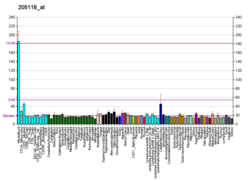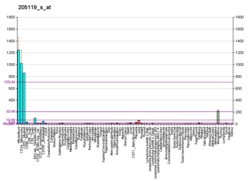Formyl peptide receptor 1 (FPR1, FPR1 receptor, fMet-Leu-Phe receptor 1, FMLP receptor 1, or N-formylmethionyl-leucyl-phenylalanine receptor 1) is a cell surface receptor protein that in humans is encoded by the formyl peptide receptor 1 (FPR1) gene. This gene encodes a G protein-coupled receptor cell surface protein that binds and is activated by N-Formylmethionine-containing oligopeptides, particularly N-Formylmethionine-leucyl-phenylalanine (FMLP). FPR1 is prominently expressed by mammalian phagocytic and blood leukocyte cells where it functions to mediate these cells' responses to the N-formylmethionine-containing oligopeptides which are released by invading microorganisms and injured tissues. FPR1 directs these cells to sites of invading pathogens or disrupted tissues and then stimulates these cells to kill the pathogens or to remove tissue debris; as such, it is an important component of the innate immune system that operates in host defense and damage control.[5]
Humans also express two paralogs of FPR1 vis., FPR2 and FPR3. Mice express no fewer than 7 Fpr receptors and encoding genes that are homologous to FPR1 although no single one of these FPRs appears to perform exactly the same functions as any one of the human FPRs.[6]
- ^ a b c GRCh38: Ensembl release 89: ENSG00000171051 – Ensembl, May 2017
- ^ a b c GRCm38: Ensembl release 89: ENSMUSG00000045551 – Ensembl, May 2017
- ^ "Human PubMed Reference:". National Center for Biotechnology Information, U.S. National Library of Medicine.
- ^ "Mouse PubMed Reference:". National Center for Biotechnology Information, U.S. National Library of Medicine.
- ^ "Entrez Gene: Formyl peptide receptor 1".
- ^ Cite error: The named reference
Migeotte_2006was invoked but never defined (see the help page).





